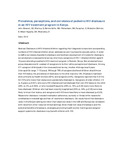| dc.contributor.author | John-Stewart, GC | |
| dc.contributor.author | Wariua, G | |
| dc.contributor.author | Beima-Sofie, KM | |
| dc.contributor.author | Richardson, BA | |
| dc.contributor.author | Farquhar, C | |
| dc.contributor.author | Maleche-Obimbo, E | |
| dc.contributor.author | Mbori-Ngacha, DA | |
| dc.contributor.author | Wamalwa, D | |
| dc.date.accessioned | 2013-06-07T12:33:27Z | |
| dc.date.available | 2013-06-07T12:33:27Z | |
| dc.date.issued | 2012 | |
| dc.identifier.citation | AIDS Care. 2012 Dec 2 | en |
| dc.identifier.uri | http://www.ncbi.nlm.nih.gov/pubmed/23256520 | |
| dc.identifier.uri | http://erepository.uonbi.ac.ke:8080/xmlui/handle/123456789/30100 | |
| dc.identifier.uri | http://www.tandfonline.com/doi/full/10.1080/09540121.2012.749333 | |
| dc.description.abstract | Disclosure to HIV-infected children regarding their diagnosis is important as expanding numbers of HIV-infected children attain adolescence and may become sexually active. In order to define correlates of pediatric disclosure and facilitate development of models for disclosure, we conducted a cross-sectional survey of primary caregivers of HIV-1 infected children aged 6-16 years attending a pediatric HIV treatment program in Nairobi, Kenya. We conducted focus group discussions with a subset of caregivers to further refine perceptions of disclosure. Among 271 caregiver/child dyads in the cross-sectional survey, median child age was 9 years (interquartile range: 7-12 years). Although 79% of caregivers believed children should know their HIV status, the prevalence of disclosure to the child was only 19%. Disclosure had been done primarily by health workers (52%) and caregivers (33%). Caregivers reported that 5 of the 52 (10%) who knew their status were accidentally disclosed to. Caregivers of older children (13 vs. 8 years; p<0.001), who were HIV-infected and had disclosed their own HIV status to the child (36% vs. 4%; p=0.003), or who traveled frequently (29% vs. 16%, p=0.03) were more likely to have disclosed. Children who had been recently hospitalized (25% vs. 44%, p=0.03) were less likely to know their status, and caregivers with HIV were less likely to have disclosed (p=0.03). Reasons for disclosure included medication adherence, curiosity or illness while reasons for nondisclosure included age and fear of inadvertent disclosure. Our study found that disclosure rates in this Kenyan setting are lower than observed rates in the USA and Europe but consistent with rates from other resource-limited settings. Given these low rates of disclosure and the potential benefits of disclosure, strategies promoting health worker trainings and caregiver support systems for disclosure may benefit children with HIV. | en |
| dc.language.iso | en | en |
| dc.subject | Disclosure | en |
| dc.subject | Pediatric | en |
| dc.subject | HIV, | en |
| dc.subject | Stigma | en |
| dc.subject | Adherence | en |
| dc.title | Prevalence, perceptions, and correlates of pediatric HIV disclosure in an HIV treatment program in Kenya. | en |
| dc.type | Thesis | en |
| local.publisher | College of health science,University of Nairobi | en |


